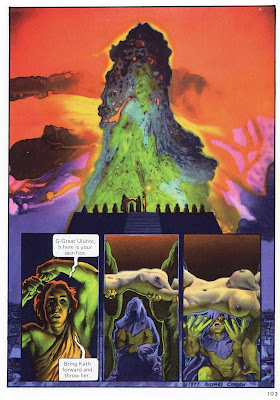by Richard Corben
Catalan Communications 1984
'Den' started out as a short animated film Richard Corben made in 1968. In 1975 - 1976, a 12-part 'Den: Neverwhere' comic was printed in the French magazine Metal Hurlant. An English language translation was reprinted in the U. S. magazine Heavy Metal in 1977 - 1978.
This Catalan Communications trade paperback compiles all the 'Den: Neverwhere' episodes into a well-made book, with quality stock paper and reproductions. There is an Introduction by Philip Jose Farmer.
It goes without saying that the Den feature in Heavy Metal was a quintessential part of late 70s stoner culture, and a major factor in the magazine's initial popularity.
Looking at Den over 40 years later, with the 'Woke' mindset now permeating popular culture, it can be easy to regard it as a quaint example of a 70s 'underground' comic gone aboveground into some degree of respectability.......a comic designed to market T & A fantasies to young males. A comic that objectifies women and amplifies their subservience to the Male Gaze.
It would, however, be unfair to dismiss Den in this manner.
Den is best regarded as a product of its times, when sf and fantasy comics with an 'adult' sensibility were commonplace in European pop culture, but considered an aberrant sideline for U.S. publishers. That is why Heavy Metal and Den had the impact they did, back in 1977.
It's true that Den's plot - essentially a recycling of the planetary romance stories of Edgar Rice Burroughs and Robert E. Howard - was simple and unadorned, designed to appeal to its demographic of men under 30. But the fact that Den addressed the suppressed ids of that demographic shouldn't detract from the advances its artwork - and in particular, its color - brought to comics.
Corben's unique acetate-overlay technique for color printing gives his illustrations a visual impact that would not be duplicated until the comics industry began to adopt the use of computer-generated coloring techniques in the mid-80s. As Corben explains it: I invented a techinque - my system of color overlays - which apparently nobody can understand, but it's really very simple. The luminescent quality of my color overlays is derived from the way I combine the colors. I shoot the photomechanical separations myself, to a slightly higher contrast than a normal photo engraver would do. This makes the colors appear brighter. I'm excited when I do finally see the colors. I can see if my ideas work well or not so well.
Den: Neverwhere works in a lot of Corben's 'cinematic' visual style, by using different points of view and perspectives, along with a more imaginative approach to the use of his layouts and page designs.
Unfortunately, 'Den: Neverwhere' has long been out of print, and copies have very steep asking prices. Assembling the relevant issues of Heavy Metal is impractical for much the same reason. Hopefully you can luck out like I did, and find a copy for an affordable price on the shelves of your local comics shop.
UPDATE: April, 2023. Dark Horse Books plans to release a 128-page hardcover volume of 'Den' in August, 2023. The promotional blurb for this volume states it will contain 'bonus' material, as well as restored pages and new lettering. The projected retail price is $34.99.















































































